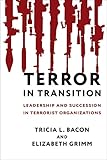Terror in Transition : leadership and succession in terrorist organizations / Tricia L. Bacon and Elizabeth Grimm.
Material type: TextSeries: Columbia studies in terrorism and irregular warfarePublisher: New York : Columbia University Press, [2022]Description: x, 300 pages ; 23 cmContent type:
TextSeries: Columbia studies in terrorism and irregular warfarePublisher: New York : Columbia University Press, [2022]Description: x, 300 pages ; 23 cmContent type: - text
- unmediated
- volume
- 9780231192248
- 9780231192255
- 363.325 23/eng/20220204
- HV6431 .B324 2022
| Item type | Current library | Collection | Call number | Copy number | Status | Notes | Barcode | |
|---|---|---|---|---|---|---|---|---|
 Books
Books
|
Rabdan Academy General Stacks | General Collection | HV6431 .B324 2022 (Browse shelf(Opens below)) | C. 1 | Available | AED 106.00 | 22529 | |
 Books
Books
|
Zayed Military University General Stacks | General Collection | HV6431 .B324 2022 (Browse shelf(Opens below)) | C. 2 | Available | $ 121.88 | 22554 |
Browsing Zayed Military University shelves,Shelving location: General Stacks,Collection: General Collection Close shelf browser (Hides shelf browser)
Includes bibliographical references and index.
Introduction -- Literature Review and Research Design -- Founders: Who Is A Founder, What Does He Do, and Who Comes Next? -- The Second Klux Klan-From Founder to Fixer -- Egyptian Islamic Jihad-From Founder to Figureheads to Fixer to Visionary -- Al-Qaida in Iraq/Islamic State of Iraq-From Founder to Signalers -- Al-Shabaab-From Founder to Fixer to Figurehead -- Pathways and Possibilities: Lessons Learned from the Mini-Case Studies -- Conclusion.
"Today's counterterrorism experts are engaged in a spirited debate about whether or not targeting the leader of a known terrorist group is an effective strategy, but in reality, not much is actually known about the organizational and strategic role leaders play in terrorist groups. In this book, security studies experts Tricia Bacon and Elizabeth Grimm Arsenault develop a set of criteria of the techniques that leaders of often decentralized terrorist groups have used to successfully survive and analyze how that criteria has been used in practice by al-Qaeda and the Islamic State. These criteria--such as forging partnerships with other groups, articulating a strategic vision, and promoting a clear chain of command--draw from multidisciplinary models of leadership and thus expand the reach of political science and security studies' understanding of how these leaders operate. Further, Bacon and Arsenault point out that by better understanding terrorist leaders, policymakers can make sounder decisions about combating terrorism through methods like countering violent extremism, deradicalization, and targeted combat action. How Terrorist Leaders Matter provides an essential re-working of established ways of thinking about terrorist organizations and how to better counter their reach and influence"-- Provided by publisher.
There are no comments on this title.






